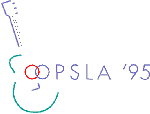 Business Object Design and Implementation Workshop
Business Object Design and Implementation Workshop
 Business Object Design and Implementation Workshop
Business Object Design and Implementation Workshop
 Position Paper
Position Paper Experiences
With a Manufacturing Framework
Experiences
With a Manufacturing Framework Seldon
L. Stewart and James A. St. Pierre (selden@nist.gov)
Seldon
L. Stewart and James A. St. Pierre (selden@nist.gov) Organization
Organization
 Date/Place: 16 October 1995/Austin, TX
Date/Place: 16 October 1995/Austin, TX
We are halfway through a three-year joint project with SEMATECH on a Computer-Integrated Manufacturing Framework (CIMF). The results of the first year of that project are reported in: Roadmap for the Computer-Integrated Manufacturing (CIM) Application Framework, available as http://elib.cme.nist.gov/msid/pubs/stewart95a.pdf (or .ps) and from SEMATECH in hardcopy as Tech Transfer 95052825A-ENG. The purpose of this project is to promote and standardize a general, object-oriented framework for manufacturing. Business objects are a very broad class, of which manufacturing objects are only a part. However, manufacturing plays a major role in the economy. Every business is a consumer of manufactured products, and many businesses are in manufacturing. As a result it is important that a CIM framework be closely integrated into any larger business or enterprise framework.
Successful integration is based on well-defined and widely accepted interfaces. Thus the object-oriented approach with its emphasis on interface specification is well adapted to integration. Unfortunately, specification of interface signatures, as with CORBA/IDL, is only a necessary but not sufficient condition for integration to be successful. The more difficult question is how to specify what an interface does, without overly constraining possible implementations. We suggest that this is significant problem for this workshop to address.
In our report we defined for stages of development for a framework:
These stages are in logical order, but generally their execution will overlap to a large degree. Results from any one stage will feed both backwards and forwards to the other stages. We also developed recommendations for how to carry out such a program. While some of the recommendations are quite specific to the project at hand, many can be restated for more general frameworks. Here are recommendations that we believe might be applicable to a wide range of business application frameworks.
These are recommendations based on our experience studying one framework in a particular application domain. However, the framework is large and manufacturing is a significant application domain.
What are good ways to specify the semantics (the "what") of an interface without overly specifying the details of the implementation (the "how")?
 Business Object Design and Implementation
Business Object Design and Implementation